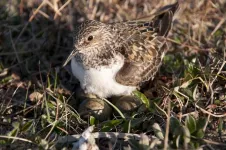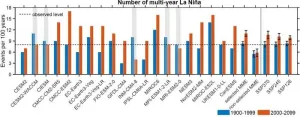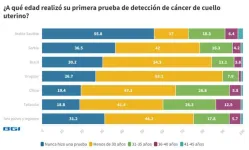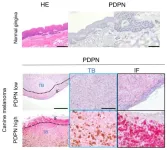(Press-News.org) About 15 years ago, researchers reported that the timing of spring in high-Arctic Greenland had advanced at some of the fastest rates of change ever seen anywhere in the world. But, according to new evidence reported in the journal Current Biology on July 26, that earlier pattern has since been completely erased. Instead of coming earlier and earlier, it seems the timing of Arctic spring is now driven by tremendous climate variability with drastic differences from one year to the next.
“As scientists we are obliged to revisit previous work to see whether the knowledge obtained at that time still holds,” says Niels Martin Schmidt (@NielsMSchmidt) of Aarhus University in Denmark. “We looked at previously reported extreme rates of phenological advancements in the Arctic and found that directional advancement is no longer the prevailing pattern. Actually, the previously observed trend has disappeared completely and has been replaced by extreme year-to-year variation in the onset of spring.”
Global changes in climate are expected to take place faster in the Arctic than in places at lower latitudes. To follow those trends, researchers at Zackenberg in Northeast Greenland launched an ecosystem-wide monitoring program in 1996. Among a suite of ecosystem variables, the program also tracks the timing of spring based on flowering plants, arthropod emergence, and bird nesting.
When the first 10 years of data were analyzed for 1996–2005, the findings showed a clear pattern of advancement across plants and animals included in the study. For instance, they saw some arthropods emerging up to 4 weeks earlier. In the new study, Schmidt and his colleagues wanted to see how these trends look now that they have 15 additional years of data available.
After analyzing the phenological data from 1996–2020, they report little evidence of directional change in the timing of events even as climate change continues. The researchers attribute this shift to a high degree of climate variability from year to year.
“That the extreme rates of phenological advancement we reported back in 2007 would not have continued unabated was not surprising to us,” Schmidt said. “However, that we see such a consistent shift from directional to extreme variability across so many different organisms and that the entire ecosystem now seems driven by variation in climatic conditions, was surprising.”
Schmidt says that the previous pattern showed steadily rising temperatures and declining snow cover. Now, what they see is a lot messier. Temperature increases have stalled while snow cover fluctuates dramatically from year to year.
“Some years have almost no snow in spring, whereas others have snow on the ground way into the summer season,” he says. “This leaves us with a generally warmer but much more unpredictable spring climate—and this is where the second contributor to the observed phenological shift kicks in. Some species appear unable to take advantage of the warmer conditions in spring and appear to have reached the limits of their phenological plasticity.”
Plants and animals have some flexibility that allows them to track the climatic conditions in their environment, he explains. Arctic species in particular appear to have a high degree of phenological plasticity. Even so, the new evidence suggests that some species are already being pushed about as far as they can go. For instance, they don’t flower as early in warm summers as one might expect. As the Arctic continues to warm, the researchers predict that a growing number of species will become “increasingly out of sync with the climatic conditions.”
The new findings highlight the unfortunate reality that the lack in directional change does not mean that the climate is stable. In this case, quite the opposite is true. The climate pattern shows wide variation that may be pushing organisms and whole ecosystems to their limits. The researchers will continue to explore species-specific responses to the shifting climate pattern and its effects on essential interactions, such as pollination. They hope to learn how the responses of an individual species will cascade through the community. The findings are a reminder of the importance of long-term study.
“These insights can only be obtained because of sustained, ecosystem-wide, long-term monitoring with rigorous field sampling across more than 25 years at a very remote corner of the world,” Schmidt says. “Continued long-term monitoring is key to understand ecosystems and to detect changes in dynamics.”
###
This work was supported by the Danish Environmental Protection Agency, the Kvantum Institute at the University of Oulu, Academy of Finland, the Jane and Aatos Erkko Foundation, and the European Research Council.
Current Biology, Schmidt et al. “Little directional change in the timing of Arctic spring phenology over the past 25 years” https://www.cell.com/current-biology/fulltext/S0960-9822(23)00823-0
Current Biology (@CurrentBiology), published by Cell Press, is a bimonthly journal that features papers across all areas of biology. Current Biology strives to foster communication across fields of biology, both by publishing important findings of general interest and through highly accessible front matter for non-specialists. Visit: http://www.cell.com/current-biology. To receive Cell Press media alerts, contact press@cell.com.
END
The United States has more than 10 times the number of mass shooting incidents than other developed countries, yet little research has shown the distribution and types of shootings, geographically.
“I’m constantly asked, ‘What is public health doing about the rise in mass shootings?” says Leslie Barnard, MPH, a student working with the University of Colorado School of Medicine’s Firearm Injury Prevention Initiative.
Barnard, a doctoral candidate in the Department of Epidemiology in the Colorado School of Public Health at the CU Anschutz Medical Campus, wanted to find answers to address public ...
Eighty-two percent of child deaths in low-income countries could be prevented, according to a study from the international CHAMPS network published in JAMA Network Open. The study, which used the minimally invasive autopsy technique developed by the Barcelona Institute for Global Health (ISGlobal), found an infectious agent in 87% of cases and identified malnutrition as the most common underlying cause of death.
Ninety-nine percent of deaths in children under five years of age occur in low- and middle-income countries. "If we want to prevent these deaths, we need to know the causes, but the problem is that we lack reliable data," says Quique Bassat, ...
About The Study: The findings of this study including 268 counties in 22 states suggest that wastewater surveillance can provide an accurate assessment of county SARS-CoV-2 incidence and may be the best metric for monitoring amount of circulating virus as home testing increases and disease acuity decreases because of vaccination and treatment.
Authors: Meri R. J. Varkila, M.D., of Stanford University in Palo Alto, California, is the corresponding author.
To access the embargoed study: Visit our For The Media website at this link https://media.jamanetwork.com/
(doi:10.1001/jamanetworkopen.2023.25591)
Editor’s Note: Please ...
About The Study: This secondary analysis of a randomized clinical trial including 19,000 older adults found a significant increase in intracranial bleeding with daily low-dose aspirin but no significant reduction of ischemic stroke. These findings may have particular relevance to older individuals prone to developing intracranial bleeding after head trauma (e.g., from falls).
Authors: John J. McNeil, Ph.D., of Monash University in Melbourne, Australia, is the corresponding author.
To access the embargoed study: Visit our For The Media website at this link https://media.jamanetwork.com/
(doi:10.1001/jamanetworkopen.2023.25803)
Editor’s ...
The El Niño–Southern Oscillation (ENSO) is the Earth's most consequential interannual climate fluctuation. Alternating irregularly between warm El Niño and cold La Niña phases, it brings shifts in ocean surface temperature and disrupts wind and rainfall patterns across the tropics.
Unlike El Niño, which usually lasts one year, La Niña tends to develop after an El Niño and lasts for two consecutive years or more. This is known as a multiyear La Niña event and exerts prolonged and aggregated impacts, such as increased wildfires, flooding, and altered ...
Earth is truly unique among our Solar System’s planets. It has vast water oceans and abundant life. But Earth is also unique because it is the only planet with plate tectonics, which shaped its geology, climate and possibly influenced the evolution of life.
Plate tectonics describes the movement and interaction of tectonic plates on Earth’s surface. This movement is driven by the very slow creeping motion of Earth's mantle, called convection, which carry heat from the interior to our planet's ...
Alcohol is one of the most commonly used psychoactive drugs, with a growing number of users in many parts of the world. Despite the awareness regarding its adverse effects, individuals can get habituated to alcohol consumption, leading to a medical condition called alcohol use disorder (AUD). AUD is characterized by the abuse, dependency, and addiction of alcohol, leading to compromised social responses and interactions of the individual. Moreover, it impairs spatial working memory (memory that allows us to orient ourselves ...
Researchers have found that people with obstructive sleep apnea have an increased cardiovascular risk due to reduced blood oxygen levels, largely explained by interrupted breathing. Obstructive sleep apnea has long been associated with increased risk of cardiovascular issues, including heart attack, stroke, and death, but the findings from this study, partially supported by the National Institutes of Health and published in the American Journal of Respiratory and Critical Care Medicine, show the mechanism mostly responsible ...
Research from the Registro Nacional de Cáncer notes that Uruguay has the highest cancer incidence and mortality rates in Latin America. In particular, cervical cancer is the third leading cause of cancer related morbidity among Uruguay's female population.
To further motivate action to combat cervical cancer, BGI Genomics today released its State of Cervical Cancer Awareness Report in Uruguay. This report assesses the level of knowledge, attitudes, and practices related to cervical cancer screening and the human papillomavirus (HPV) vaccine. By examining these key areas, this survey seeks to highlight the associated barriers and opportunities. ...
Although rare, mucosal melanoma in humans has a low survival rate. It has been difficult to investigate due to a lack of similar cancers in animals for study. Researchers explored a protein common to human and canine mucosal melanoma. The protein seems to be what makes this cancer so problematic, as it mobilizes the cancer cells, allowing them to spread. Researchers hope that eliminating this protein could lead to a potential treatment. The study is published in Molecular Cancer Research, a journal of the American Association for Cancer Research.
Melanoma is a type of cancer that begins in ...





